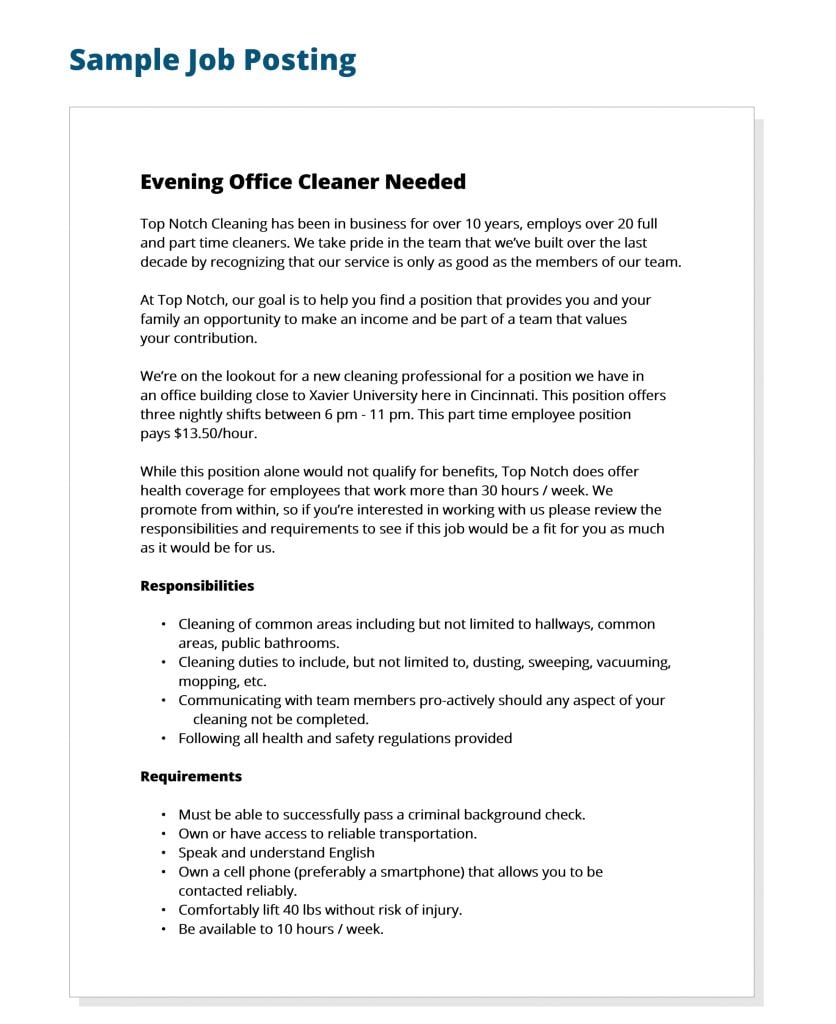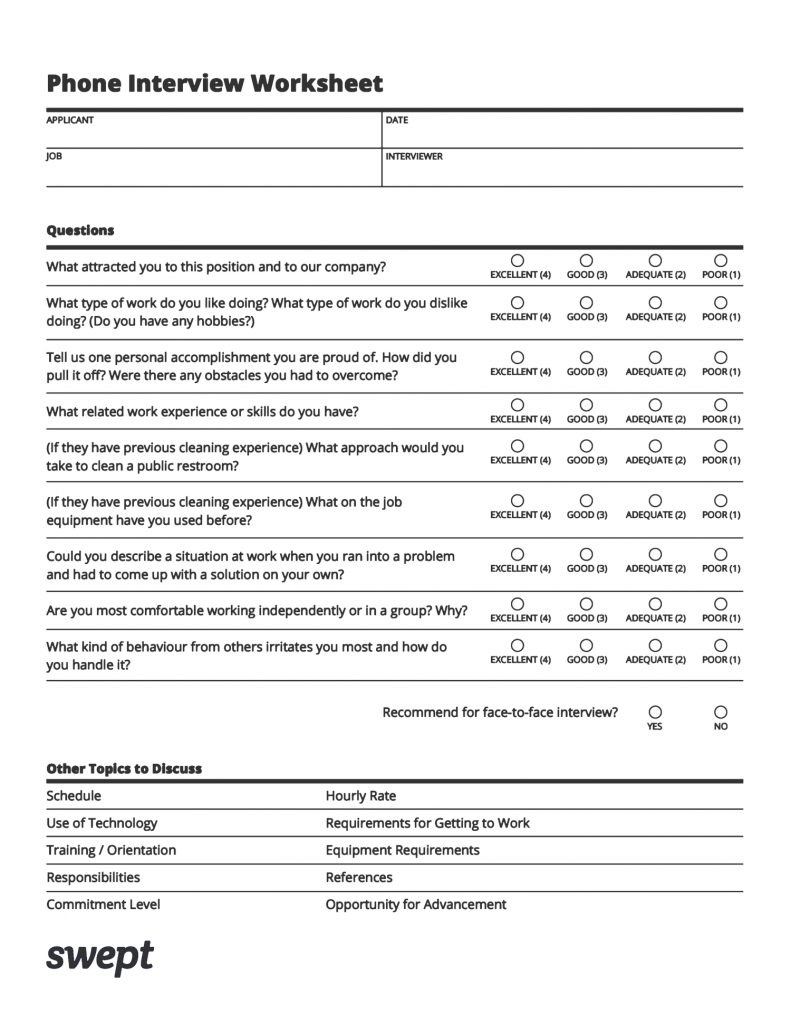How To Hire A Janitor
One of, if not the biggest, issues plaguing the commercial janitorial industry today is employee retention. Here are the top 3 tips on how to hire a janitor for your commercial cleaning or janitorial business.
The cleaning industry dwarfs other industries’ highest turnover rates by no less than 250%. With as many as 300% of cleaners leaving their jobs every year,
Staggering numbers, right? Well, as much as we stress that you need to use every tool in your shed to keep those cleaners happy and working, we want to step back and talk about how you can improve retention as early as the hiring process. How? Glad you asked. Let’s get into it…
Let’s start with what we know. We know that janitorial businesses are built on people. We know that you want to hire great cleaners for your business and that great cleaners want to work for busy cleaning companies with consistent hours. So, how do you get the attention of reliable, hard-working janitors? How do you figure out who is a good fit for your cleaning company? And very importantly, how do you make them stay with you long-term? We’ve got it all figured out, and we’re ready to share what we’ve learned about hiring and keeping great cleaners.
These three cleaning company hiring tools will save you time and money by teaching you how to find the right people for your janitorial business and how to keep them with you for a long time:
-
Writing Job Descriptions: Make Sure the Right People Find You.
-
Interviewing the Right Way to Find the Right People.
-
Keeping Great Employees and Letting Them Find MORE Great Employees
Hire A Janitor Chapter #1 - Job descriptions
Writing Job Descriptions & Making Sure the Right People Find You.
Writing a proper job description doesn’t have to be hard. The main goal is to get attention from the right kind of people, who will fit in at your cleaning company, work hard, and eventually refer more great employees to you. Describing what the cleaning position has to offer and what makes it a good job to have is a great place to start.
Job descriptions are made up of three main elements:
-
Introduction. Three or four short paragraphs that describe your cleaning company, what your goals are, what kind of new cleaner would be a good fit, the hours, pay, location and any employee benefits that are offered.
Tip: This is a great place to let applicants know what makes being a cleaner with your company a good job — mention the flexibility and being able to work independently. Sell it! There are a lot of excellent candidates out there who may not have considered cleaning but would be a great fit for your team.
This part of the job description to hire a janitor should answer these questions:
-
Why is this company any different from all the other cleaning jobs?
-
What type of job is this?
-
How much will I be paid?
-
Is there flexibility in time I can work?
-
How far away is this job from where I live now?
-
How many hours do / can I work?
-
Do they offer any type of health coverage?
-
Will any training be provided?
-
Who will I report to?
-
Will I be a contractor or an employee?
-
Responsibilities. This should be a bullet-point list outlining the kinds of tasks and duties that will be required by the cleaner on the job. This is the right place to list any communications requirements. Set the expectation early on that when everyone communicates effectively, a better job gets done and clients are happier.
This part of the job description should answer these questions:
-
What equipment do I need to know how to use?
-
What duties are expected of me?
-
Will I need to work in a team or by myself?
-
Requirements. Here’s where you list the basic job requirements. This is the right place to weed out applicants who are not a good fit for your cleaning company. Be clear about what a job applicant will need to even be considered for a cleaning position.
This part of the job description should answer these questions:
-
Do I need to pass a criminal background check?
-
Do I need my own car or can I use public transportation?
-
Do I need experience?
-
Will I need a cell phone?
-
Do I need to speak English?
-
Do I need to be able to read English?
-
Will I need to be able to lift heavy things or operate any equipment?
These points and descriptions are all very well and good you say…but at the end of the day, what does it all look like?
Well, it should look something like this :

Where should I post my job descriptions?
Stat: Between 2014 to 2019 online job searching has tripled. A survey released that year showed that 65% of Americans have researched jobs on the internet.*
Hire A Janitor Chapter #2 - The Interview
The Right Way to Find the Right People

Now that you’ve written proper job descriptions for your cleaning company and posted them online, you’ve likely received quite a collection of resumes or applications.
Before we dive into the interviewing process, we should touch on the step in between — choosing who to interview based on their resume. This is called screening job applicants. Not everyone who sends a resume your way will be the right fit for a janitorial company cleaner position. So, how do you choose who has potential?
Before the Interviews: Screening Applicants
The first thing to keep in mind is that your ideal applicant could be anywhere in the pile. It’s important to thoroughly read through all the job applications. Start by organizing the resumes into two piles as you review them.
Pile #1 – Has Potential
-
The applicant meets all requirements listed in the on-the-job description.
-
The applicant has experience in this field.
-
The applicant has provided references.
Pile #2 – Not the Right Fit
-
The applicant does not meet all the requirements listed in the on-the-job description.
-
The applicant did not fill in all the mandatory information on the application.
-
The applicant is simply not qualified.
The “Has Potential” pile will now become your interview list. To save time, first schedule short phone interviews with the applicants on this list. The interviews should be roughly 10–15 minutes long. After the phone interviews, you may move a few more resumes into the “Not the Right
Fit” pile. The remaining applicants will be invited to come in for in-person interviews. Congratulations! The screening process is now complete!
STAT: Evidence shows that mobile devices are often the main or only connection to the internet for low-income workers. Make sure your application process is easy to complete on a mobile device.
How To Conduct a Great Phone Interview

What are the right questions to ask during a phone interview? The goal of the interview is to determine if the applicant’s skills, personality, and expectations of the job match the position you’re looking to fill. A 10- to 15-minute long phone interview can definitely achieve this goal if you know what to ask. Phone interviews also save you time by eliminating applicants who are not the right fit for in-person interviews.
We understand that most applicants won’t describe janitorial cleaning as their passion or dream career, so the goal of the phone interview is simple: look for signals that the position you’re looking to fill matches the needs of this person beyond just making money to pay the bills.
Phone Interview Questions
-
What attracted you to this position and our company?
Starting with a broad, open-ended question is a great way to immediately get insight into the applicant’s personal and professional goals. This will help you determine if they’re in it for the long haul—are they looking to commit to a job long-term with consistent hours and perhaps even growth opportunities within the company—or are they simply between jobs in their (other) desired profession?
Try to get a feel for what stage of life they’re in and how that will affect potential longevity in this position.
-
What type of work do you like doing? What type of work do you dislike doing?
Let’s be honest, you’re looking for someone who enjoys doing manual and sometimes repetitive work. Having the applicants talk about their professional likes and dislikes, will give great insight into what kinds of tasks they’ll do well at. Throw in a personal question, too, about their hobbies and interests to get a feel for activities they are naturally drawn to in their free time.
-
Tell us one personal accomplishment you are proud of. How did you pull it off? Were there any obstacles you had to overcome?
Asking for a story about a personal accomplishment will help to show the applicant’s ability to follow through, think critically, problem-solve, and get the job done. Try and carefully gauge their level of enthusiasm for this answer, as it will give you a sense of whether they take pride in their work.
-
What related work experience or skills do you have?
This one’s a biggie. Finding out how much cleaning industry experience an applicant has immediately tells you if they can handle this kind of work, as well as how much training they’ll need. For applicants who have 5-10 years of experience cleaning, ask more specific questions to figure out what technical skills they already have.
If the applicant has never worked in the cleaning industry before, it’s still important to ask specific questions about their roles and responsibilities at other jobs in order to identify transferable skills.
-
Could you describe a situation at work when you ran into a problem and had to come up with a solution on your own?
Typically you won’t be on-site with a cleaner when most issues come up, so you need to hire people who have common sense, are resourceful, and have basic problem-solving skills. Listen to their answer to this question and assess if their solution makes sense. Bonus points for creativity!
-
Are you most comfortable working independently or in a group? Why?
Cleaners need to be able to work effectively and as part of a team effectively. Asking this question helps to identify the applicant’s comfort level in either setting.
-
What kind of behaviour from others irritates you most, and how do you handle it?
This is a great question as it shows you the applicant’s level of maturity and how they deal with different personalities or other people’s difficult behaviour. Even when cleaners are working independently, they have to be able to work well with other team members, including supervisors and managers.
Why Use the Interview Worksheet?
Using a simple scoring system, as shown in the sample worksheets, is an easy way to keep things consistent while ranking applicants. The worksheet will guide you along through the seven questions, and remind you of additional topics and questions.
TIP: Save time by only setting up face-to-face interviews with the right applicants. Those whose answers you weren’t satisfied with should not move on to the next step!

Face-to-Face Interviews
This is the big moment! The final stage of the hiring process. This an opportunity to really decide if this person will be a cultural fit for your cleaning company.
Studies have shown that over 80%, (or 12.5 times more communication is done without words) of communication is non-verbal.* That’s why meeting applicants in person is an important part of the hiring process.
Think about it, your customers experience your brand through your cleaners. The attitude, body language, and level of professionalism your team displays will directly affect how clients think of your cleaning company. Make sure you get the right people — by knowing what to look for at a face-to-face interview. What does the applicant’s presence say about their character, attitude, and level of professionalism?
Physical Cues to Look For:
-
Eye Contact
-
Posture
-
Personal Grooming
-
Energy Level
-
Sense of Humour
-
Overall Demeanour
Here’s a free worksheet to help you out, feel free to use it!
Hire A Janitor Chapter #2 - Six steps to creating an employee referral program

Want to learn how to tap into your existing staff (especially those rockstar team members) to attract more hard-working cleaners? It’s easier than you think. We’ve put together six straightforward steps for setting up your own employee referral plan—helping your overall recruitment goals.
As we’ve talked about in chapters one and two, finding the right people helps save you time and money on hiring and training.
Step #1 – Set a Goal
It’s impossible to measure how successful any kind of plan is without setting goals. The employee referral program is no different — what does success look like? How and when will you know it’s working? Just as importantly — how will you know if it’s not working?
Setting goals helps you to understand just what your cleaning company got out of the time spent on creating the referral program. Working toward reaching that goal is a great motivator on busy days when there are a million other things to do — keep your eyes on the prize! So, what exactly is the prize? Well, that depends.
Define your goals by answering these questions:
-
For what time of day do I need more cleaners?
-
How many cleaners do I need?
-
How long will the contract be?
Example Goal: I need to hire three more night-time cleaners for a new six-month contract.
Tip: Give your managers and supervisors access to these goals to help guide everyone in the same direction. Having them clearly written down and easy to find is a great start for the program.
Step #2 – Make the Program Easy to Use… Like, Really Easy

The harder it is to use the program, the fewer people who will even try. Make the entire process both easy to understand and easy to do.
Example 1: Create a simple form that asks them for the referral’s name and contact info.
Example 2: Simply ask them to text you the referral’s name and contact info!
Step #3 – Motivate People to Participate
Next, give your existing staff a reason to want to refer other cleaners. Money or something of value like a pre-paid gift card is always a great motivator. Referral programs are proven to reduce turnover in your cleaning company. Think about what it usually costs to advertise and recruit people, and be sure to compensate successful referrals accordingly.
The bonus structure can work really well here, as you could pay your team members per successful referral, and tack it onto their paychecks.
Monthly highlights of those who are using the referral program and what they’ve earned in bonuses is a fantastic way to motivate others to start using it. Is there a staff communications board, email newsletter or other ways of sending out this information?
Step #4 – Reach Out to Every Person Referred
You’ve put in the effort to start the program and asked your cleaners to take the time to send you the referrals — it would just look bad if you didn’t reach out to everyone who was referred. To ensure greater success and to make everyone involved feel appreciated, reach out to every person who is referred.
Tip 1: Draft an email template that you can save which is the pre-written response to a referral. That way, you can simply copy and paste the message into a new email each time you need to.
Tip 2: The response email should clearly outline how this person can properly apply for the job.
Step #5 – Talk About the Referral Program, A Lot

This one might seem obvious, but it can often get skipped, given how busy everyone is all the time. To design your communications plan, answer the following questions:
-
How will I talk about the referral program?
-
Where can I communicate the referral program?
-
How many times per week, or month, should I communicate the referral program?
-
Where can people go to get information on the referral program at any time?
Mentioning the referral program during the onboarding process is a very effective way to get the message across right away. All of the information should also be available somewhere online so that employees can access it at any time.
Remember to have the key information included in these communication pieces, like:
-
How to send referrals to you.
-
How much they will be compensated?
-
When they will be compensated?
-
Are they being compensated per referral, or per successful referral?
-
What is a successful referral?
To manage expectations, it can be helpful to communicate that not everyone who is referred will be hired. This is also a great place to post positions you’re currently looking to fill.
Step #6 – Measure, Measure, Measure!
Here’s the part where you find out how to measure your success. After all, we can only improve what we measure. Decide which Key Performance Indicators (KPIs) you want to track in order to determine if the program is working. Then benchmark how you were doing before you started the program.
For example, how many hires from referrals did you get last quarter before you started a program? Then, how many did you get the quarter you launched the program? With those numbers, you can figure out the percentage increase. Other examples of KPIs are:
-
% of referred candidates you contact – commit to your team.
-
% of qualified referrals – are they sending you the right people?
-
% of staff that participate – do you need to get the word out better? Improve the offer?
-
Cost to hire organically versus through the referral program – determine your return on investment (ROI)
In Closing…
This brings our guide to hiring to an end. We hope you enjoyed the guide and that its tricks, tips, and worksheets give you and your janitorial company ongoing value. As always, Swept strives to deliver the most valuable content we can gather to help you grow. Because your success is our success. If you have any suggestions on how we can make this guide better, or just want to leave a comment or review, head on over to our Facebook page and share with us. Don’t be shy.
Swept is dedicated to highlighting stories that touch everyone in the janitorial industry. Having started as a commercial cleaning company ourselves, our hearts go well beyond the janitorial software we offer.
Learn more about Swept’s cleaning company software here.
How to Hire Janitorial Staff


